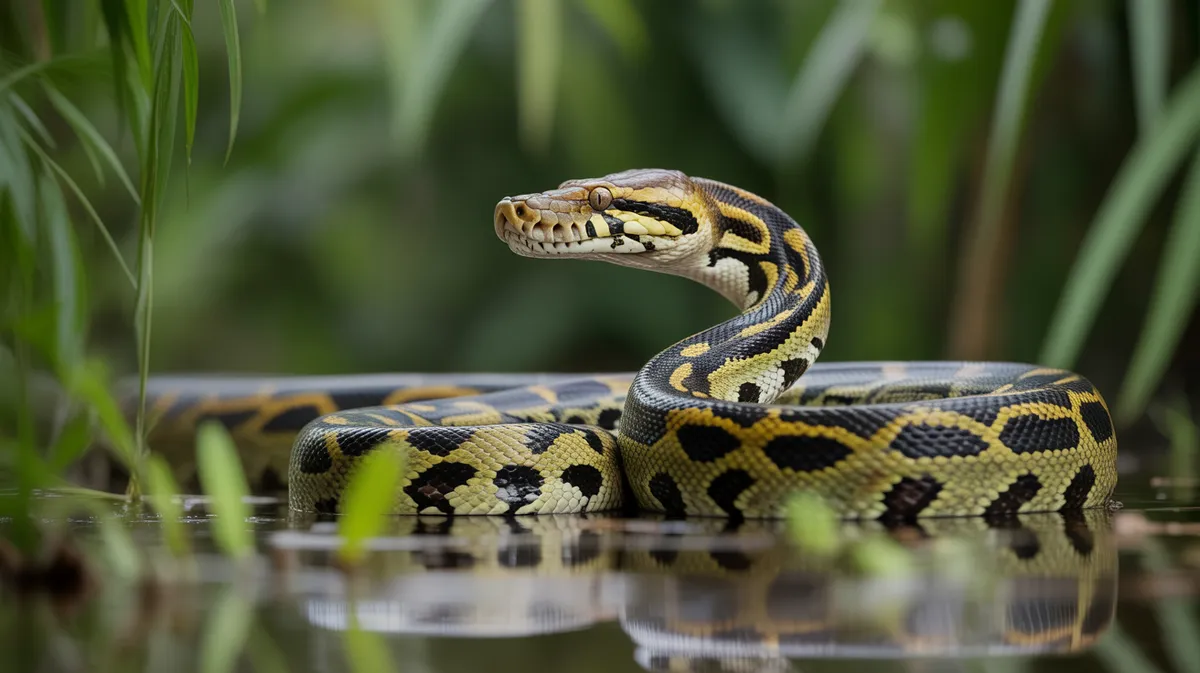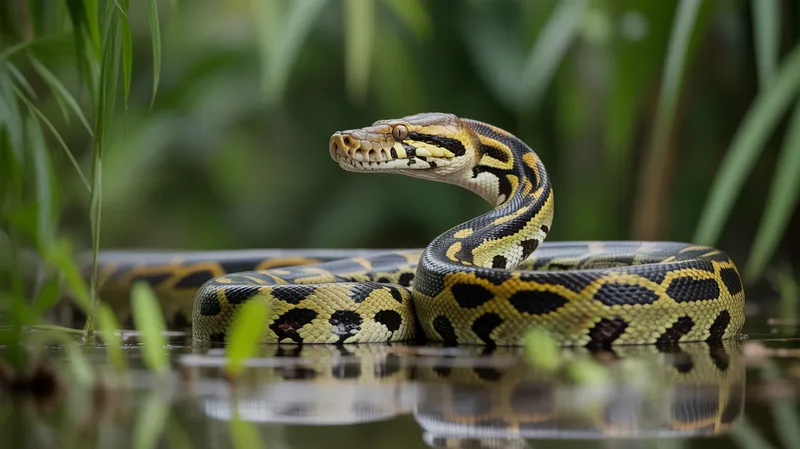
Borneo Python
Python breitensteini

Meet the Borneo Python
The Borneo python, also known as the Borneo short-tailed python, is a non-venomous constrictor native to the island of Borneo in Southeast Asia. This species is notable for its stout body, short tail, and distinctive patterning, which ranges from yellowish-brown to dark brown with bold blotches. Adapted to a semi-aquatic lifestyle, it is often found near marshes, swamps, and rainforests. Though they are powerful predators, Borneo pythons are generally secretive and rarely encountered in the wild. Their calm demeanor makes them popular among experienced reptile enthusiasts.
Classification
Reptile
Habitat
Tropical rainforest and wetlands
Diet
Carnivore
Lifespan
20-25 years
Conservation
Least Concern
Weight
5-15 kg
📖Fascinating Facts
Rainforest Resident
Borneo pythons thrive in the humid lowland rainforests and wetlands of Borneo, often near rivers and swamps.
Short-Tailed Constrictor
They are easily recognized by their unusually short tails compared to other python species, which helps in identification.
Heat Sensing
These pythons possess specialized heat-sensing pits that allow them to locate warm-blooded prey even in complete darkness.
📋Detailed Description
The Borneo python (Python breitensteini) is a robust, medium-sized python species endemic to the island of Borneo. Adults typically reach lengths of 1.5 to 2.5 meters (5–8 feet), with some exceptional individuals exceeding 2.7 meters (9 feet), and can weigh up to 12 kilograms (26 lbs). Its body is notably thick and muscular, with a short, blunt tail accounting for less than 10% of total body length—a trait distinguishing it from many other python species. The dorsal coloration consists of a complex mosaic of yellowish-brown, reddish, and dark brown blotches, providing effective camouflage among leaf litter and muddy substrates. The head is broad and triangular, with heat-sensing pits along the upper and lower labial scales, allowing detection of warm-blooded prey even in low-light conditions. The ventral surface is lighter, often cream or pale yellow, aiding in concealment when viewed from below in aquatic environments. The species is primarily terrestrial but exhibits strong swimming abilities, frequently occupying marshes, peat swamps, and riverine forests. Borneo pythons are solitary and secretive, spending much of their time concealed under logs, in burrows, or submerged in shallow water. Their calm disposition and tolerance of handling have contributed to their popularity in the exotic pet trade, though they require experienced care due to their size and strength.
💡 Did you know?
Despite their intimidating appearance, Borneo pythons are known for their relatively docile temperament, especially in captivity.
🔬Research & Sources
Wikipedia Summary
The Borneo python, also known commonly as the Borneo short-tailed python, is a species of non-venomous snake in the family Pythonidae. The species is endemic to the island of Borneo.
Last Modified: 1/17/2025
🎭Behavior & Social Structure
Borneo pythons are primarily nocturnal, becoming most active during the early evening and night. They are ambush predators, relying on their cryptic coloration and stillness to surprise prey, which includes small mammals (such as rodents and treeshrews), birds, and occasionally reptiles. Using their heat-sensing pits, they can accurately strike at warm-blooded animals even in total darkness. After striking, they employ powerful constriction to subdue prey before swallowing it whole. Feeding frequency is relatively low, with adults often eating only once every few weeks. These pythons are generally solitary outside of the breeding season, exhibiting little social interaction. They are known to be tolerant of conspecifics in overlapping territories, but direct encounters are rare. During the day, they seek shelter in dense vegetation, animal burrows, or under debris to avoid predators and regulate body temperature.
👶Reproduction & Life Cycle
Breeding in Python breitensteini typically occurs during the rainy season, from November to March, coinciding with increased prey availability. Males locate receptive females by following pheromone trails. Courtship involves tongue-flicking and body alignment, with males sometimes engaging in mild combat for access to females. Females are oviparous, laying clutches of 8 to 20 eggs, though clutch size can vary with female size and condition. Incubation lasts approximately 60 to 70 days at temperatures of 30–32°C (86–90°F). Females exhibit maternal care by coiling around the eggs and engaging in shivering thermogenesis—muscle contractions that generate heat to maintain optimal incubation temperatures. Hatchlings emerge at about 30–40 cm (12–16 inches) in length and are immediately independent, dispersing to find shelter and food.
🛡️Adaptations & Survival
The Borneo python exhibits several adaptations for its semi-aquatic and terrestrial lifestyle. Its stout body and short tail enhance maneuverability in dense undergrowth and muddy substrates. The cryptic dorsal patterning provides camouflage against leaf litter and waterlogged forest floors, reducing predation risk and aiding ambush hunting. Heat-sensing pits enable precise detection of endothermic prey in low-visibility environments. The species' ability to remain submerged for extended periods (up to 30 minutes) allows it to escape predators and approach prey undetected. Its slow metabolism and infrequent feeding are adaptations to the unpredictable availability of prey in rainforest and swamp habitats. Additionally, the female's capacity for shivering thermogenesis during egg incubation is a rare trait among reptiles, enhancing reproductive success in fluctuating environmental conditions.
📚Research Sources
🎨Cultural Significance
The Borneo python does not have the prominent mythological or symbolic status of some other Southeast Asian snakes, but it is occasionally featured in local folklore as a spirit animal or omen. Indigenous communities may regard large pythons with a mixture of respect and caution, sometimes attributing supernatural qualities to them. In some rural areas, the species is hunted for food or traditional medicine, though this is less common than with larger python species. In the global context, the Borneo python is valued in the exotic pet trade for its striking appearance and manageable size, contributing to its recognition among reptile enthusiasts.
🔬Recent Research & Discoveries
Recent research on Python breitensteini has focused on its phylogenetic relationships within the short-tailed python complex, with molecular studies confirming its distinct species status separate from the closely related Python curtus and Python brongersmai. Ecological studies have highlighted its role as a mid-level predator in Borneo's wetland ecosystems, contributing to rodent population control. There is ongoing research into the effects of habitat fragmentation on its genetic diversity and movement patterns, using radio telemetry and genetic markers. Captive breeding programs have provided insights into reproductive physiology, including the mechanisms of shivering thermogenesis and egg incubation. Further studies are needed to assess population health, habitat requirements, and the impact of the pet trade on wild populations.
🎥Wildlife Videos

Wild Indonesia | Episode 1: Islands of Monsters | Free Documentary
Wild Indonesia - Episode 1: Islands of Monsters | Wildlife Documentary Watch 'Wild Indonesia - Episode 2' here: ...
Free Documentary - Nature

Borneo: Earth's Ancient Eden - Full Documentary | Love Nature
The island of Borneo has spent more time in the tropics than any other region on Earth – some 120 million years. Become a Love ...
Love Nature

Borneo's Secret Kingdom: King of the Swamp #animals #borneo #wildlife #4k
The Kinabatangan-Segama Wetlands is a large, pristine coastal ecosystem in Southeast Asia. In the wet season, proboscis ...
Wild Nature Now

Capturing an Angry Python | Expedition Borneo | BBC Studios
One of the Expedition Borneo team members goes on a humanitarian mission to re-house a 3metre long python that is terrorising ...
BBC Studios

Wildlife Encounters on Borneo's Longest River | Full Documentary
Starting at Imbak Falls, wildlife photographer Cede Prudente together with boatman Rizal start their journey down Borneo's ...
Free High-Quality Documentaries

Extreme Snakes | Africa | Full episode | Animal documentary
Discover how the snakes of Africa evolved of millions of years. Explore diverse ecosystems, witness the behavior of magnificent ...
WildNature HDTv
🌍Habitat Information
The Borneo Python typically inhabits Tropical rainforest and wetlands environments. Borneo Pythons have adapted to their environments with specialized features and behaviors.
Primary Habitat:
Tropical rainforest and wetlands
More detailed habitat information will be available soon.
🛡️Conservation Status
The Borneo Python is currently classified as Least Concern. Conservation efforts are crucial for preserving this species for future generations.
Common Threats:
- 🏠Habitat loss and fragmentation
- 🌡️Climate change impacts
- 🎯Hunting and poaching
- 🏭Human-wildlife conflict
⚠️Threats & Conservation Challenges
While currently listed as Least Concern by the IUCN, the Borneo python faces several localized threats. Habitat loss due to deforestation, peatland drainage, and conversion of wetlands for agriculture (notably oil palm plantations) is a significant concern, reducing available habitat and prey. The species is also subject to collection for the pet trade and, to a lesser extent, for its skin. Although not targeted as heavily as some other python species, overharvesting in certain areas could impact local populations. Road mortality and persecution by humans—often due to fear or perceived threat to livestock—pose additional challenges. Climate change, with its potential to alter rainfall patterns and wetland hydrology, may further affect the species' habitat and reproductive success. Population trends are not well-documented, but ongoing habitat monitoring is recommended.
🔬Scientific Classification
Scientific Name
Python breitensteini
Classification Hierarchy
🔍 About Taxonomic Classification
Taxonomic classification is a hierarchical system used by scientists to classify and organize living organisms based on shared characteristics and evolutionary relationships.
The system moves from broad categories (Kingdom) to increasingly specific ones, with each animal's scientific name typically consisting of its Genus and species.
📝Community Notes
Share your observations and insights about the Borneo Python with our community of wildlife enthusiasts.
Join Our Community
Sign in to share your observations and connect with fellow wildlife enthusiasts.
Sign In to ContributeNo community notes yet
Be the first to share your observations about the Borneo Python!
Explore Borneo Python
Select a tab above to learn more about this amazing animal.
📸Photo Gallery
No photos available for this animal yet.
🌟Discover More Wildlife
Continue your journey of discovery with more fascinating animals from our database
